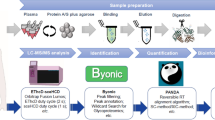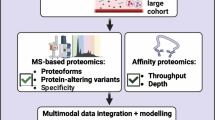Abstract
Aim
To identify the potential metabolite markers in diabetic retinopathy (DR) by using gas chromatography coupled with time-of-flight mass spectrometry (GC-TOFMS).
Methods
GC-TOFMS spectra were acquired from vitreous and aqueous humor (AH) samples of patients with DR and non-diabetic participants. Comparative analysis was used to elucidate the distinct metabolites of DR. Metabolic pathway was employed to explicate the metabolic reprogramming pathways involved in DR. Logistic regression and receiver-operating characteristic analyses were carried out to select and validate the biomarker metabolites and establish a therapeutic model.
Results
Comparative analysis showed a clear separation between disease and control groups. Eight differentiating metabolites from AH and 15 differentiating metabolites from vitreous were highlighted. Out of these 23 metabolites, 11 novel metabolites have not been detected previously. Pathway analysis identified nine pathways (three in AH and six in vitreous) as the major disturbed pathways associated with DR. The abnormal of gluconeogenesis, ascorbate–aldarate metabolism, valine–leucine–isoleucine biosynthesis, and arginine–proline metabolism might weigh the most in the development of DR. The AUC of the logistic regression model established by d-2,3-Dihydroxypropanoic acid, isocitric acid, fructose 6-phosphate, and l-Lactic acid in AH was 0.965. The AUC established by pyroglutamic acid and pyruvic acid in vitreous was 0.951.
Conclusions
These findings have expanded our understanding of identified metabolites and revealed for the first time some novel metabolites in DR. These results may provide useful information to explore the mechanism and may eventually allow the development of metabolic biomarkers for prognosis and novel therapeutic strategies for the management of DR.




Similar content being viewed by others
References
Wang L et al (2017) Prevalence and ethnic pattern of diabetes and prediabetes in China in 2013. JAMA 317(24):2515–2523
Yang QH et al (2019) Prevalence of diabetic retinopathy, proliferative diabetic retinopathy and non-proliferative diabetic retinopathy in Asian T2DM patients: a systematic review and meta-analysis. Int J Ophthalmol 12(2):302–311
Klein BE (2007) Overview of epidemiologic studies of diabetic retinopathy. Ophthalmic Epidemiol 14(4):179–183
Ciulla TA, Amador AG, Zinman B (2003) Diabetic retinopathy and diabetic macular edema: pathophysiology, screening, and novel therapies. Diabetes Care 26(9):2653–2664
Li X et al (2011) Metabolomics study of diabetic retinopathy using gas chromatography-mass spectrometry: a comparison of stages and subtypes diagnosed by Western and Chinese medicine. Mol BioSyst 7(7):2228–2237
Albers JW et al (2010) Effect of prior intensive insulin treatment during the Diabetes Control and Complications Trial (DCCT) on peripheral neuropathy in type 1 diabetes during the Epidemiology of Diabetes Interventions and Complications (EDIC) Study. Diabetes Care 33(5):1090–1096
Group AC et al (2008) Intensive blood glucose control and vascular outcomes in patients with type 2 diabetes. N Engl J Med 358(24):2560–2572
Brasacchio D et al (2009) Hyperglycemia induces a dynamic cooperativity of histone methylase and demethylase enzymes associated with gene-activating epigenetic marks that coexist on the lysine tail. Diabetes 58(5):1229–1236
El-Osta A et al (2008) Transient high glucose causes persistent epigenetic changes and altered gene expression during subsequent normoglycemia. J Exp Med 205(10):2409–2417
Chalmers J, Cooper ME (2008) UKPDS and the legacy effect. N Engl J Med 359(15):1618–1620
Pirola L et al (2010) Epigenetic phenomena linked to diabetic complications. Nat Rev Endocrinol 6(12):665–675
Fang J et al (2017) Metabolomics combined with pattern recognition and bioinformatics analysis methods for the development of pharmacodynamic biomarkers on liver fibrosis. Mol BioSyst 13(8):1575–1583
Baharum SN, Azizan KA (2018) Metabolomics in systems biology. Adv Exp Med Biol 1102:51–68
Tomasova P et al (2019) Metabolomics based on MS in mice with diet-induced obesity and type 2 diabetes mellitus: the effect of vildagliptin, metformin, and their combination. Appl Biochem Biotechnol 188(1):165–184
Jaeger C et al (2017) Compound annotation in liquid chromatography/high-resolution mass spectrometry based metabolomics: robust adduct ion determination as a prerequisite to structure prediction in electrospray ionization mass spectra. Rapid Commun Mass Spectrom 31(15):1261–1266
Phua LC et al (2013) Global gas chromatography/time-of-flight mass spectrometry (GC/TOFMS)-based metabonomic profiling of lyophilized human feces. J Chromatogr B Analyt Technol Biomed Life Sci 937:103–113
Yin S et al (2017) Optimization of GC/TOF MS analysis conditions for assessing host-gut microbiota metabolic interactions: Chinese rhubarb alters fecal aromatic amino acids and phenol metabolism. Anal Chim Acta 995:21–33
Gao J et al (2016) Association between serum bile acid profiles and gestational diabetes mellitus: a targeted metabolomics study. Clin Chim Acta 459:63–72
Wang S et al (2018) Association of serum metabolites with impaired fasting glucose/diabetes and traditional risk factors for metabolic disease in Chinese adults. Clin Chim Acta 487:60–65
Floegel A et al (2013) Identification of serum metabolites associated with risk of type 2 diabetes using a targeted metabolomic approach. Diabetes 62(2):639–648
Qiu Y et al (2014) A distinct metabolic signature of human colorectal cancer with prognostic potential. Clin Cancer Res 20(8):2136–2146
Xia J, Wishart DS (2016) Using metaboanalyst 3.0 for comprehensive metabolomics data analysis. Curr Protoc Bioinform 55:14101–141091
Ke C et al (2016) Metabolic phenotyping for monitoring ovarian cancer patients. Sci Rep 6:23334
Zhang F, Du G (2012) Dysregulated lipid metabolism in cancer. World J Biol Chem 3(8):167–174
Wang X et al (2013) Metabolomics and proteomics annotate therapeutic properties of geniposide: targeting and regulating multiple perturbed pathways. PLoS ONE 8(8):e71403
Haines NR et al (2018) Metabolomics Analysis of Human Vitreous in Diabetic Retinopathy and Rhegmatogenous Retinal Detachment. J Proteome Res 17(7):2421–2427
Zhu DD et al (2018) The role of uric acid in the pathogenesis of diabetic retinopathy based on Notch pathway. Biochem Biophys Res Commun 503(2):921–929
Vidhya S et al (2018) Free amino acids hydroxyproline, lysine, and glycine promote differentiation of retinal pericytes to adipocytes: a protective role against proliferative diabetic retinopathy. Exp Eye Res 173:179–187
Sanchez-Chavez G et al (2016) Potential role of endoplasmic reticulum stress in pathogenesis of diabetic retinopathy. Neurochem Res 41(5):1098–1106
Ola MS et al (2013) Neurodegeneration and neuroprotection in diabetic retinopathy. Int J Mol Sci 14(2):2559–2572
Gong MT et al (2018) Comprehensive analysis of gene expression profiles associated with proliferative diabetic retinopathy. Exp Ther Med 16(4):3539–3545
Romero-Aroca P et al (2018) Glomerular filtration rate and/or ratio of urine albumin to creatinine as markers for diabetic retinopathy: a ten-year follow-up study. J Diabetes Res 2018:5637130
Lauritzen T et al (1983) Effect of 1 year of near-normal blood glucose levels on retinopathy in insulin-dependent diabetics. Lancet 1(8318):200–204
MacGregor LC et al (1986) Altered retinal metabolism in diabetes. I. Microanalysis of lipid, glucose, sorbitol, and myo-inositol in the choroid and in the individual layers of the rabbit retina. J Biol Chem 261(9):4046–4051
Kumaramanickavel G et al (2002) Inducible nitric oxide synthase gene and diabetic retinopathy in Asian Indian patients. Clin Genet 61(5):344–348
Komeima K et al (2006) Antioxidants reduce cone cell death in a model of retinitis pigmentosa. Proc Natl Acad Sci USA 103(30):11300–11305
Ashino H et al (2003) Novel function of ascorbic acid as an angiostatic factor. Angiogenesis 6(4):259–269
Sinclair AJ et al (1991) Disturbed handling of ascorbic acid in diabetic patients with and without microangiopathy during high dose ascorbate supplementation. Diabetologia 34(3):171–175
Brownlee M (2001) Biochemistry and molecular cell biology of diabetic complications. Nature 414(6865):813–820
Wang QJ (2006) PKD at the crossroads of DAG and PKC signaling. Trends Pharmacol Sci 27(6):317–323
Xia P et al (1994) Characterization of the mechanism for the chronic activation of diacylglycerol-protein kinase C pathway in diabetes and hypergalactosemia. Diabetes 43(9):1122–1129
Koya D, King GL (1998) Protein kinase C activation and the development of diabetic complications. Diabetes 47(6):859–866
Galvez MI (2011) Protein kinase C inhibitors in the treatment of diabetic retinopathy. Review Curr Pharm Biotechnol 12(3):386–391
Sheetz MJ et al (2011) Effect of ruboxistaurin (RBX) on visual acuity decline over a 6-year period with cessation and reinstitution of therapy: results of an open-label extension of the Protein Kinase C Diabetic Retinopathy Study 2 (PKC-DRS2). Retina 31(6):1053–1059
Sheetz MJ et al (2013) The effect of the oral PKC beta inhibitor ruboxistaurin on vision loss in two phase 3 studies. Invest Ophthalmol Vis Sci 54(3):1750–1757
Narayanan SP et al (2014) Arginase 2 deficiency reduces hyperoxia-mediated retinal neurodegeneration through the regulation of polyamine metabolism. Cell Death Dis 5:e1075
Narayanan SP et al (2013) Arginase in retinopathy. Prog Retin Eye Res 36:260–280
Lynch CJ, Adams SH (2014) Branched-chain amino acids in metabolic signalling and insulin resistance. Nat Rev Endocrinol 10(12):723–736
Zhao X et al (2016) The Relationship between branched-chain amino acid related metabolomic signature and insulin resistance: a systematic review. J Diabetes Res 2016:2794591
Yoon MS (2016) The emerging role of branched-chain amino acids in insulin resistance and metabolism. Nutrients 8(7):405–417
Kappel BA et al (2017) Effect of empagliflozin on the metabolic signature of patients with type 2 diabetes mellitus and cardiovascular disease. Circulation 136(10):969–972
Bhattacharya S et al (2014) Validation of the association between a branched chain amino acid metabolite profile and extremes of coronary artery disease in patients referred for cardiac catheterization. Atherosclerosis 232(1):191–196
Ola MS, Alhomida AS, LaNoue KF (2019) Gabapentin attenuates oxidative stress and apoptosis in the diabetic rat retina. Neurotox Res. https://doi.org/10.1007/s12640-019-00018-w
Hung CM et al (2012) mTOR-dependent cell survival mechanisms. Cold Spring Harb Perspect Biol. https://doi.org/10.1101/cshperspect.a008771
Dan HC et al (2008) Akt-dependent regulation of NF-κB is controlled by mTOR and Raptor in association with IKK. Genes Dev 22(11):1490–1500
Wei J et al (2016) Blocking mammalian target of rapamycin (mTOR) attenuates HIF-1α pathways engaged-vascular endothelial growth factor (VEGF) in diabetic retinopathy. Cell Physiol Biochem 40(6):1570–1577
Jacot JL, Sherris D (2011) Potential therapeutic roles for inhibition of the PI3K/Akt/mTOR pathway in the pathophysiology of diabetic retinopathy. J Ophthalmol 2011:589813
Adini I et al (2003) RhoB controls Akt trafficking and stage-specific survival of endothelial cells during vascular development. Genes Dev 17(21):2721–2732
Herat LY et al (2018) Focusing on sodium glucose cotransporter-2 and the sympathetic nervous system: potential impact in diabetic retinopathy. Int J Endocrinol 2018:9254126
Li L et al (2017) Metabolomics reveal mitochondrial and fatty acid metabolism disorders that contribute to the development of DKD in T2DM patients. Mol BioSyst 13(11):2392–2400
Lu J et al (2011) Closing the anion gap: contribution of D-lactate to diabetic ketoacidosis. Clin Chim Acta 412(3–4):286–291
Chou CK et al (2015) Elevated urinary D-lactate levels in patients with diabetes and microalbuminuria. J Pharm Biomed Anal 116:65–70
Chou J et al (2018) Fasting serum alphahydroxybutyrate and pyroglutamic acid as important metabolites for detecting isolated post-challenge diabetes based on organic acid profiles. J Chromatogr B Analyt Technol Biomed Life Sci 1100–1101:6–16
Makahleh A, Ben-Hander GM, Saad B (2015) Determination of alpha-ketoglutaric and pyruvic acids in urine as potential biomarkers for diabetic II and liver cancer. Bioanalysis 7(6):713–723
Acknowledgements
We acknowledge Dr Xun Xu (MD) from our department for providing medical writing assistant.
Funding
This work was supported in part by grants from National Key R&D Program of China (No. 2016YFC0904800) and National Natural Science Foundation of China (No. 81870666).
Author information
Authors and Affiliations
Corresponding authors
Ethics declarations
Conflict of interest
The authors have declared that there are no conflicts of interest.
Statement of human and animal rights
The study was prospectively approved by the Ethics Committee of Shanghai First People’s Hospital of Shanghai Jiaotong University, and research was conducted in accordance to the Declaration of Helsinki.
Informed consent
Signed informed consent was obtained from all participants enrolled in the study.
Additional information
Managed by Massimo Porta.
Publisher's Note
Springer Nature remains neutral with regard to jurisdictional claims in published maps and institutional affiliations.
Electronic supplementary material
Below is the link to the electronic supplementary material.
Rights and permissions
About this article
Cite this article
Wang, H., Fang, J., Chen, F. et al. Metabolomic profile of diabetic retinopathy: a GC-TOFMS-based approach using vitreous and aqueous humor. Acta Diabetol 57, 41–51 (2020). https://doi.org/10.1007/s00592-019-01363-0
Received:
Accepted:
Published:
Issue Date:
DOI: https://doi.org/10.1007/s00592-019-01363-0




